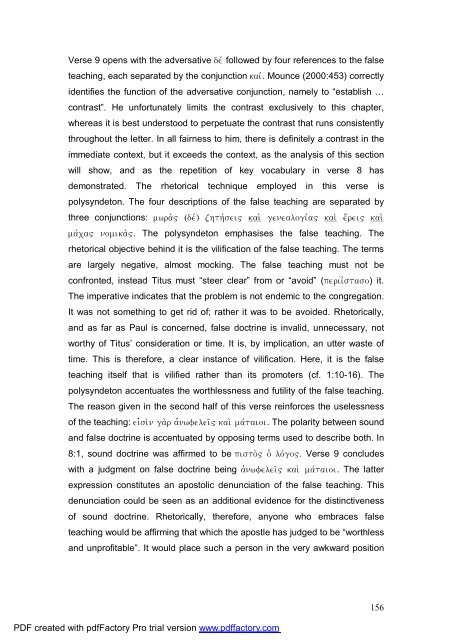A Text centred rhetorical analysis of Paul's Letter to Titus
A Text centred rhetorical analysis of Paul's Letter to Titus
A Text centred rhetorical analysis of Paul's Letter to Titus
Create successful ePaper yourself
Turn your PDF publications into a flip-book with our unique Google optimized e-Paper software.
Verse 9 opens with the adversative dev followed by four references <strong>to</strong> the false<br />
teaching, each separated by the conjunction kaiv. Mounce (2000:453) correctly<br />
identifies the function <strong>of</strong> the adversative conjunction, namely <strong>to</strong> “establish …<br />
contrast”. He unfortunately limits the contrast exclusively <strong>to</strong> this chapter,<br />
whereas it is best unders<strong>to</strong>od <strong>to</strong> perpetuate the contrast that runs consistently<br />
throughout the letter. In all fairness <strong>to</strong> him, there is definitely a contrast in the<br />
immediate context, but it exceeds the context, as the <strong>analysis</strong> <strong>of</strong> this section<br />
will show, and as the repetition <strong>of</strong> key vocabulary in verse 8 has<br />
demonstrated. The <strong>rhe<strong>to</strong>rical</strong> technique employed in this verse is<br />
polysynde<strong>to</strong>n. The four descriptions <strong>of</strong> the false teaching are separated by<br />
three conjunctions: mwra;" (dev) zhthvsei" kai; genealogiva" kai; e[rei" kai;<br />
mavca" nomika;". The polysynde<strong>to</strong>n emphasises the false teaching. The<br />
<strong>rhe<strong>to</strong>rical</strong> objective behind it is the vilification <strong>of</strong> the false teaching. The terms<br />
are largely negative, almost mocking. The false teaching must not be<br />
confronted, instead <strong>Titus</strong> must “steer clear” from or “avoid” (periivŸstaso) it.<br />
The imperative indicates that the problem is not endemic <strong>to</strong> the congregation.<br />
It was not something <strong>to</strong> get rid <strong>of</strong>; rather it was <strong>to</strong> be avoided. Rhe<strong>to</strong>rically,<br />
and as far as Paul is concerned, false doctrine is invalid, unnecessary, not<br />
worthy <strong>of</strong> <strong>Titus</strong>’ consideration or time. It is, by implication, an utter waste <strong>of</strong><br />
time. This is therefore, a clear instance <strong>of</strong> vilification. Here, it is the false<br />
teaching itself that is vilified rather than its promoters (cf. 1:10-16). The<br />
polysynde<strong>to</strong>n accentuates the worthlessness and futility <strong>of</strong> the false teaching.<br />
The reason given in the second half <strong>of</strong> this verse reinforces the uselessness<br />
<strong>of</strong> the teaching: eijsi;n ga;r ajnwfelei`" kai; mavtaioi. The polarity between sound<br />
and false doctrine is accentuated by opposing terms used <strong>to</strong> describe both. In<br />
8:1, sound doctrine was affirmed <strong>to</strong> be pis<strong>to</strong>;" oJ lovgo". Verse 9 concludes<br />
with a judgment on false doctrine being ajnwfelei`" kai; mavtaioi. The latter<br />
expression constitutes an apos<strong>to</strong>lic denunciation <strong>of</strong> the false teaching. This<br />
denunciation could be seen as an additional evidence for the distinctiveness<br />
<strong>of</strong> sound doctrine. Rhe<strong>to</strong>rically, therefore, anyone who embraces false<br />
teaching would be affirming that which the apostle has judged <strong>to</strong> be “worthless<br />
and unpr<strong>of</strong>itable”. It would place such a person in the very awkward position<br />
PDF created with pdfFac<strong>to</strong>ry Pro trial version www.pdffac<strong>to</strong>ry.com<br />
156

















